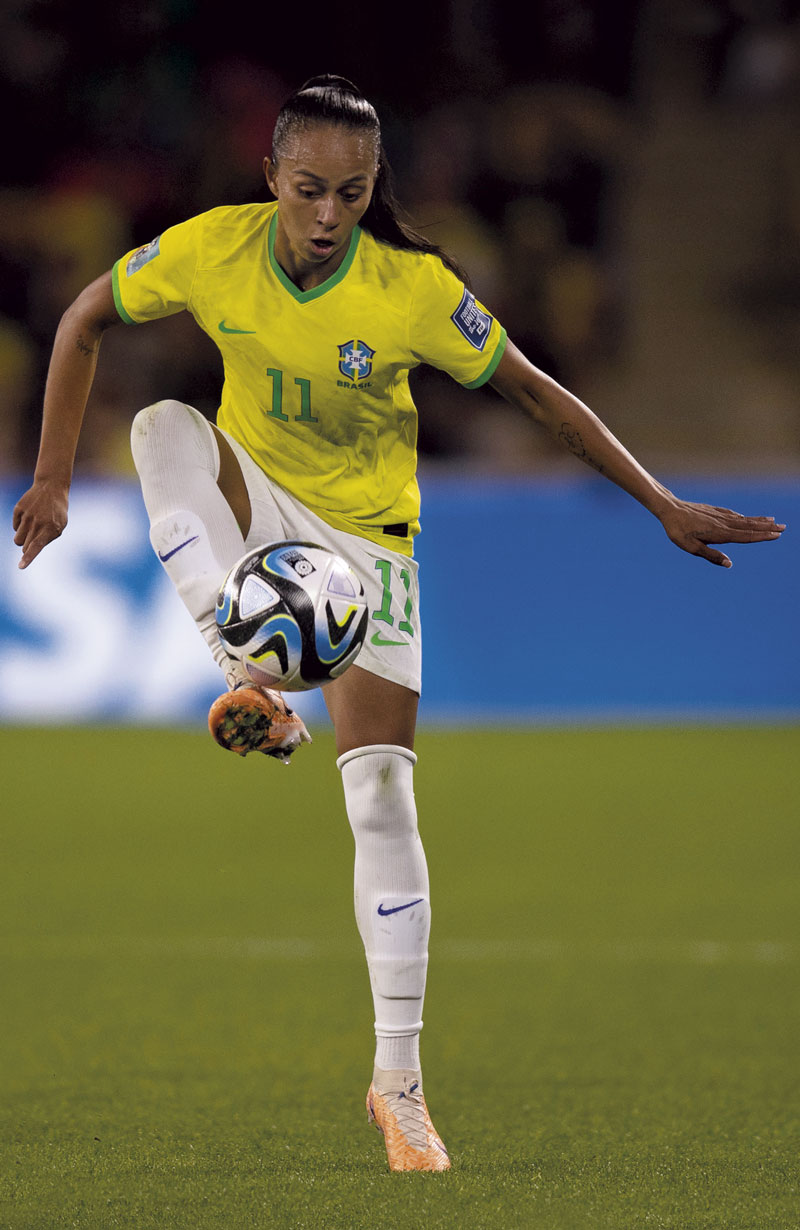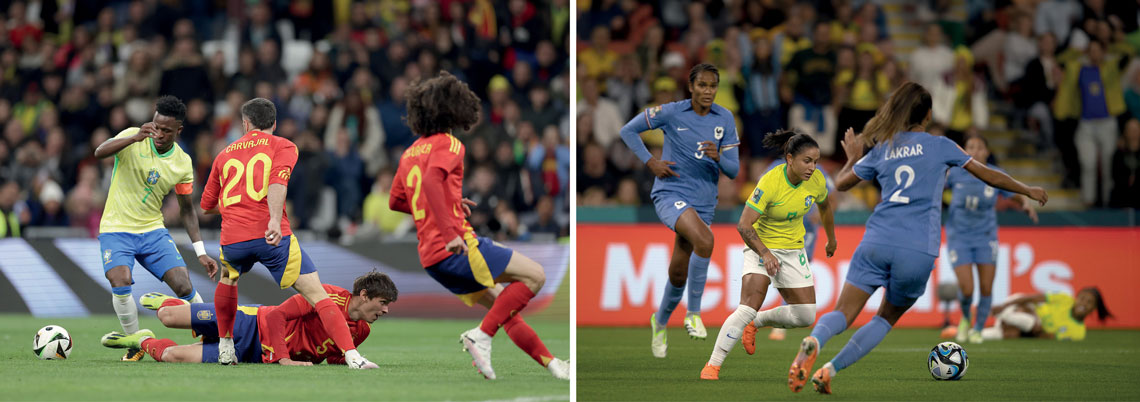
Thais Magalhães / CBFMidfielder Adriana in 2023: the next Women’s World Cup will be held in BrazilThais Magalhães / CBF
With the Copa America and European Cup behind us, most soccer fans probably have their own theory about why the Argentine and Spanish teams performed better than the rest. While there is no shortage of opinions, there are some who seek scientific evidence on the matter, such as Ronaldo Thomatieli Santos, an exercise physiologist from the Federal University of São Paulo (UNIFESP), Baixada Santista campus. Together with physical educator and postdoctoral researcher Elias de França and a group led by sports scientist Luís Branquinho of the Polytechnic Institute of Portalegre, Portugal, he has been analyzing data provided by the International Federation of Association Football (FIFA) to determine which strategies are most successful. They also study data collected during São Paulo Soccer Club games and training sessions, with the aim of understanding the most effective training methods and estimating player injury risk.
“FIFA has a special filming system that records the movements of the players and the ball during World Cup games,” explains Santos. These are much more detailed statistics than the numbers presented by TV sports channels. The researchers developed a model for analyzing the data qualitatively and quantitatively. “Artificial intelligence takes mere seconds to do calculations that would take us months to do manually,” explains Santos.
The analyses highlighted differences between teams from different continents during the 2022 Qatar World Cup. European teams scored more goals, provided more assists, attacked more, and spent more time in the attacking half. South American teams, on the other hand, spent more time in the midfield and took more shots on goal, according to articles published in the journals Trends in Sport Sciences and Journal of Human Sport & Exercise in March and April.
The best teams have more possession of the ball, make more passes, and the attackers more often receive the ball in the attacking third of the field from crosses and long passes. Staying in the attacking third and imposing the team’s style of play allows the players to create more opportunities.
In women’s soccer, physical build makes more of a difference, while among men, technical and tactical ability plays more of a role. “The Brazilian team was less physically adept—in characteristics such as strength, flexibility, and resistance — than European and North American teams, and this was a limitation for them,” points out Santos.
Early analysis of data from the 2023 Women’s World Cup in Australia and New Zealand indicates that the most successful team (Spain) was also the fastest, according to an article published in the International Journal of Performance Analysis in Sport in March. High performances in variables such as ball possession and progression, as well as long passes that break through defensive lines, allow athletes to run less, while a quick-passing style allows them to cover greater distances.
Science on Brazilian soccer fields
Santos emphasizes that these results are valid for short tournaments such as FIFA World Cups. League competitions have more room for error, requiring different strategies. In Brazil, where teams play up to 70 games per year and a lot of traveling is involved, it is impossible to maintain the same intensity as teams at a World Cup.
Through a partnership with the São Paulo FC men’s soccer team, the UNIFESP researchers were given access to data from sports vests worn by the players, in addition to information provided by the medical team. “In our day-to-day work, it is very difficult to transform the huge volume of data into useful information,” says physical trainer Adriano Titton, who was responsible for establishing the partnership with Elias de França in 2019, when he was a performance analyst for São Paulo FC’s youth team.

Rafael Ribeiro / CBF | Thais Magalhães / CBFEuropean teams like Spain (above left, in a friendly against Brazil this year) spend more time on the attack; the Brazilian women’s team suffers from being smaller on average (above right, in a defeat against France in 2023)Rafael Ribeiro / CBF | Thais Magalhães / CBF
Titton has been a fitness coach for the professional team since 2021, acting as an intermediary between the researchers and the coaching staff. The idea is to use the data generated by the devices to estimate each player’s risk of injury, divided into three levels. “Our current success rate is over 90%,” says Santos.
“The assessments allow us to adjust a player’s training load and improve recovery on an individual basis,” says Titton. For example, based on the analysis of more than 5,000 training sessions, the researchers observed that exercises involving changes of direction, deceleration, and jumping do not improve straight-line running speed, according to an article published in the journal Frontiers in Physiology in March. The research has already been expanded to 11,000 sessions and has resulted in training plans and an article that is currently in the editing stage.
Before modern technology, this kind of study was even more work than it is now. “I used pencil and paper,” recalls physiologist Turibio Leite de Barros, who did not participate in the studies carried out by Santos’s group. Barros spent 35 years as an exercise physiology professor at UNIFESP and 25 years working in parallel as a physiologist at São Paulo FC, until he retired from both roles in 2010. On each page of his notebook, he would draw a soccer field at a scale of 1:300, on which he would mark a dotted line when a player was walking, a dashed line when they were jogging, and a solid line when they were running. “Every 10 minutes I would move onto the next page.” He then used a ruler to measure the distances traveled.
Barros points out that all athletes did the same training. “We created an individual assessment that allowed us to identify each player’s strengths and weaknesses,” he says. The result was a physical fitness profile that covered strength, speed, acceleration, flexibility, and aerobic and anaerobic capacity.
He also developed a way to assess a player’s ability to perform at altitude. “We did a test in which athletes ran on a treadmill while breathing the normal air in the room or a gas mix that replicated the high-altitude air of La Paz,” he says—the Bolivian capital sits at 3,640 meters above sea level, presenting a major challenge for most athletes. Some players showed a marked performance deficit when breathing the lower oxygen content, while others suffered less. This is valuable information for coaches deciding who to select for a game.
Barros notes that the success of combining science and sports earned a lot of attention and the practice was quickly adopted on a wider scale. “The physiologist has become a key figure in soccer.”
The story above was published with the title “Soccer in academia” in issue 342 of august/2024.
Project
Analysis of the acute effect of the association of L-Leucine supplementation and interval sprints on inflammatory markers, neuropeptides related to appetite control, and their impacts on the perception of satiety and food intake in obese adults (nº 21/03601-1); Grant Mechanism Postdoctoral Fellowship; Supervisor Ronaldo Vagner Thomatieli dos Santos (UNIFESP); Beneficiary Elias de França; Investment R$347,308.83.
Scientific articles
FRANÇA, E. de et al. Associations between confederation playing style and team strength in the FIFA World Cup 2022. Trends in Sport Sciences. vol. 31, no. 1, pp. 5–16. mar. 29, 2024.
BRANQUINHO, L. et al. Comparing physical, technical and tactical performances in the World Cup Qatar 2022. Journal of Human Sport & Exercise. vol. 19, no. 2, pp. 654–66. apr. 1, 2024.
BRANQUINHO, L. et al. Identifying the ideal weekly training load for in-game performance in an elite Brazilian soccer team. Frontiers in Physiology. vol. 15, 1341791. mar. 5, 2024.
BRANQUINHO, L. et al. Relationship between key offensive performance indicators and match running performance in the FIFA Women’s World Cup 2023. International Journal of Performance Analysis in Sport. Online. mar. 27, 2024.